کتاب انگلیش تایم یک دوره محاوره 6 مرحلهای است که برای دانش آموزان پایه ابتدایی که انگلیسی را برای اولین بار مطالعه میکنند در نظر گرفته شده است. این کتاب برای کودکانی طراحی شده است که زبان انگلیسی را به عنوان زبان دوم (EFL) میآموزند و به طور کلی زبان انگلیسی را خارج از کلاس نمیشنوند.
برنامه درسی زبان انگلیسی به صورت طبیعی و با آهنگی ثابت پیش میرود و فرصتهای بسیاری را برای تمرین زبان جدید در اختیار زبانآموزان قرار میدهد. هدف این مجموعه توسعه مهارتهای شنیداری، خوانداری، نوشتاری و گفتاری زبانآموزان از طریق فعالیتهایی است که حس کنجکاوی آنان را بر میانگیزاند و برایشان جذاب و مفرح است.

سه شخصیت ثابت به نامهای Ted، Annie و سگی به نام Digger نظر زبانآموزان را به خود جلب میکنند و در کل سری کتابهای انگلیش تایم داستانهای مختلفی را به نمایش میگذارند.
سری کتابهای انگلیش تایم طوری طراحی شده است که در ادامه سری کتابهای مقدماتی مجیک تایم به کار برود. این دو کتاب میتوانند به صورت جداگانه و یا بهعنوان یک دوره هشت سطحی معرفی شوند. برنامه درسی مجیک تایم، پایه محکمی از واژگان و زبان محاورهای را آماده میکند که کتابهای انگلیش تایم بر اساس آن ساخته شده است. کتاب های انگلیش تایم در آموزشگاه زبان در کرج به صورت کاملا تخصصی و حرفه ای آموزش داده می شوند.
نویسنده: Tom Merner – Susan Rivers – Setsuko Toyama
مترجم: شقایق پوریاقوتی
هر سطح از کتاب انگلیش تایم شامل موارد زیر است:
کتاب زبانآموز به همراه CD صوتی، کتاب کار، کتاب کار با تمرین آنلاین، CD صوتی کلاسی، کتاب معلم به همراه یک CD نرمافزار بانک سؤالات و تمرین آنلاین، کارتهای تصویری، پوستر دیواری و نرمافزار itools.
مجموعه کتاب انگلیش تایم
کتاب زبانآموز
کتابهای زبانآموز دارای تصاویر زیبا و رنگی و طراحی واضح و ساده هستند. این تصاویر زبانآموزان را به صفحاتی برای کشف و تجربه زبان هدایت میکند و علاقه و انگیزهشان را افزایش میدهد. سطوح ۱ تا ۴ انگلیش تایم شامل دوازده درس چهار صفحهای و چهار درس دو صفحهای برای بازبینی هستند. هر درس دارای یک تم مشخص مانند "در خانه" یا "در مدرسه" برای ارائه یک متن به زبان انگلیسی است. هر صفحه از درس دارای عملکردهای تکزبانه است تا تمرکز صفحه مشخص باشد.
درسهای کوتاه این اجازه را به زبانآموز میدهد تا حس کند که به سرعت در حال پیشرفت است و در آنها انگیزه و اعتماد به نفس را بالا میبرد. بعد از هر سه درس، دو صفحه دوره درسهای قبلی در قالب محتوای جدی و پرمعنا ارائه میشود. بعد از مرور درسهای قبلی، برنامههای درسی آموزشی، زبانآموز را با اطلاعات اضافی و مجموعه واژگان مرتبط با موضوعاتی مانند ریاضی، طبیعت یا جغرافی آماده میکند. زبانآموزان دانش خود را در زمینههای مختلف تقویت میکنند. واژگان جدید را از طریق فعالیتهای پروژهای در برنامه درسی تمرین میکنند.
در انتهای هر کتاب زبانآموز "دیکشنری مصور من" وجود دارد که زبانآموزان واژگانی را که یاد میگیرند در آن مینویسند. علاوه بر آن چهار چک لیست به ازای هر واحد درسی وجود دارد و این فرصت را به زبانآموز میدهد تا دانستههای خود را محک بزند، بنابراین در آنها حس اعتماد به نفس ایجاد کرده و به والدین این اجازه را میدهد که پیشرفت فرزندانشان را در فراگیری زبان انگلیسی دنبال کنند.
کتاب کار انگلیش تایم
دو نسخه از کتاب کار وجود دارد. یک نسخه مستقل و یک نسخه با دسترسی به تمرین آنلاین. یک کتاب در ادامه سری کتابهای زبانآموزان است که به ازای هر صفحه از کتاب اصلی یک نسخه برای تقویت نوشتن و خواندن هر یک از درسها را فراهم میکند و فرصتی عالی برای معلمان جهت ارزیابی درک مطلب و حفظ زبان را ارائه میدهند. در کتابهای کار سطح ۱ و ۲ در بالای هر صفحه یک کادر وجود دارد که هدف هر درس زبان را برای زبانآموزان مشخص میکند تا بهعنوان مرجع و انجام تمرینات از آن استفاده کنند.
آزمونها
آزمونهای میان دوره و آزمون نهایی به شما کمک میکند تا زبانآموزان خود را از نظر تسلط بر واژگان، دستور زبان و مکالمه ارزیابی کنید.
آزمون تمرین زبانآموزان جوان کمبریج
این آزمونها در سبک امتحانات Young Learners در کمبریج برگزار میشود و شما را قادر میسازد تا انواع تکالیف مورد نیاز و مواد تمرینی را جهت آمادگی این آزمون به دست بیاورید.
حتی اگر شما دانشجویان خود را برای شرکت در این امتحانات آماده نمیکنید، با این حال میتوانید از کار برگها بهعنوان تمرین اضافی استفاده کنید.
فلسفه دوره انگلیش تایم
دورههای مجیک تایم و انگلیش تایم بر اساس این فرضیه است که کودکان وقتی حس کنجکاوی و لذت طلبیشان برانگیخته میشود و همچنین زمانی که یک زبان جدید در حجم کم و قابل کنترل ارائه میشود، بهتر یاد میگیرند. زبان جدید طبق یک برنامه پیچیده ارائه شده است که به تدریج به زبانآموزان آموخته میشود و با مرور درس قبلیشان آن را تقویت میکند، بنابراین زبانآموزان قادر هستند در هر سطح، زبانی را که آموختهاند به خاطر بسپارند.
موضوعات دوره و شرایط آن، هر دو برای کودکان آشنا هستند. زبانآموزان بلافاصله با این شرایط ارتباط برقرار میکنند و این امر منجر به تولید زبان بیشتر و حفظ آن میشود. یادگیری زبانآموزان محور حیاتی است، زیرا این فرصت را به زبانآموز میدهد تا زبان را به طریقی تولید کند که بیشتر شبیه محاوره در زندگی واقعی باشد. بدین منظور تمرینها و دوره کردن در انگلیش تایم تمرین دو نفره و تمرین گروهی را شامل میشود.
نظریه هوش چندگانه نشان میدهد که زبانآموزان در هر کلاس زبان، با سبکهای مختلف یادگیری حضور دارند. فعالیتهایی که در انگلیش تایم استفاده میشوند، طراحی شدهاند تا طیف وسیعی از این سبکهای یادگیری را در برگیرند تا بتوانند در هر درس حداکثر زبانآموزان را شامل شوند. درسهای انگلیش تایم از روش آموزشی خاصی پیروی نمیکنند. در عوض، از انواع شیوههای مختلف برای هیجانانگیزتر کردن درسهای گوناگون که باعث جلب توجه بیشتر زبانآموزان میشوند، استفاده میکنند.
زبانآموزان، زبان هدف را قبل از اینکه بخواهند آن را تولید کنند، میشنوند (این بدین معنی است که زبان آموزان قبل از تولید آموزههای خود، در معرض زبان اصلی قرا گرفتهاند). تأکید اصلی روی مهارت شنیداری است تا زبانآموزان در معرض تلفظ صحیح قرار گیرند.
طرح درس
برنامهریزی دقیق و آمادگی برای موفقیت هر درس بسیار مهم است و ممکن است نیازمند فعالیت بیشتری باشد. آمادهسازی فعالیتهای متعدد به معلمان اجازه میدهد تا سرعت درس را حفظ کنند، فعالیتهایی که کارآمد نیستند را رها کنند و تمرکز زبانآموزان را روی یادگیری نگه دارند.
یک طرح درس صحیح شامل فعالیتهایی است که زبان پیش آموخته را مرور کرده، زبان جدید را معرفی میکند و زبان را به شیوهای سازمان یافته، صحیح و لذتبخش تمرین میکند. کتاب انگلیش تایم یک طرح درس دقیق و گام به گام را برای هر صفحه از کتاب زبانآموز فراهم میکند. هر چند معلمان تشویق میشوند که این برنامههای درسی را برحسب نیازهای فردی خود تغییر دهند.
طرح درس انگلیش تایم
1- آمادهسازی و مرور
هر طرح درس با یک فعالیت سریع و سرگرم کننده آغاز میشود که زبان تدریس شده درس قبل را دوره کند. این کار به زبانآموز کمک میکند تا زبان را به یاد آورد و انگلیسی صحبت کند. ایدههای گوناگونی برای فعالیتهای مرور درسی وجود دارد.
2- آموزش زبان هدف (درس جدید)
قبل از اینکه زبانآموزان کتابهای خود را باز کنند، زبان جدید معرفی میشود تا آنها روی یادگیری معنادار زبان تمرکز کنند. پیشنهادهای گام به گام چگونگی ارائه درس جدید با استفاده از کارتهای تصویری، کارت واژگان، نمونه واقعی، نقاشیها و حرکات را در بر دارد.
3- تمرین بیشتر روی زبان هدف
زبانآموزان در این سطح کتاب خود را باز میکنند. هر صفحه از کتاب زبانآموز تکالیفی را برای تمرین بیشتر زبان فراهم میکند. کتاب معلم دستور العملهای دقیق در مورد چگونگی بهرهبرداری کامل از صفحات کتاب زبانآموز را فراهم میکند. در صورت نیاز، نسخه صوتی، پاسخنامهها و ایدههایی در مورد چگونگی بررسی تمرینها ارائه میشود.
4- بازیها و فعالیتها
تمام درسها اغلب شامل یک بازی یا فعالیت است که به زبانآموز تمرین بیشتر با زبان هدف را پیشنهاد میدهد. بازیها اغلب حرکتهای ترکیبی به همراه شعر و ترانه را به درس اضافه میکنند. فعالیتها، زبان آموختهشده را تکرار میکنند به طوری که زبانآموزان بهصورت مداوم از آنچه آموختهاند دوباره استفاده میکنند.
معلم میتواند به فراخور نیاز کلاس بازیها و فعالیتها را انتخاب کند. برای تمرین و تفریح بیشتر کار برگهای اختیاری قابل چاپ در انتهای کتاب معلم وجود دارد.هر طرح درس با یک فعالیت سریع و سرگرم کننده که زبان جدید را بازبینی میکند، به پایان میرسد و با یک حس خاتمه و نتیجه مثبت کلاس تمام می شود.
Conversation Time و طرح درس آن
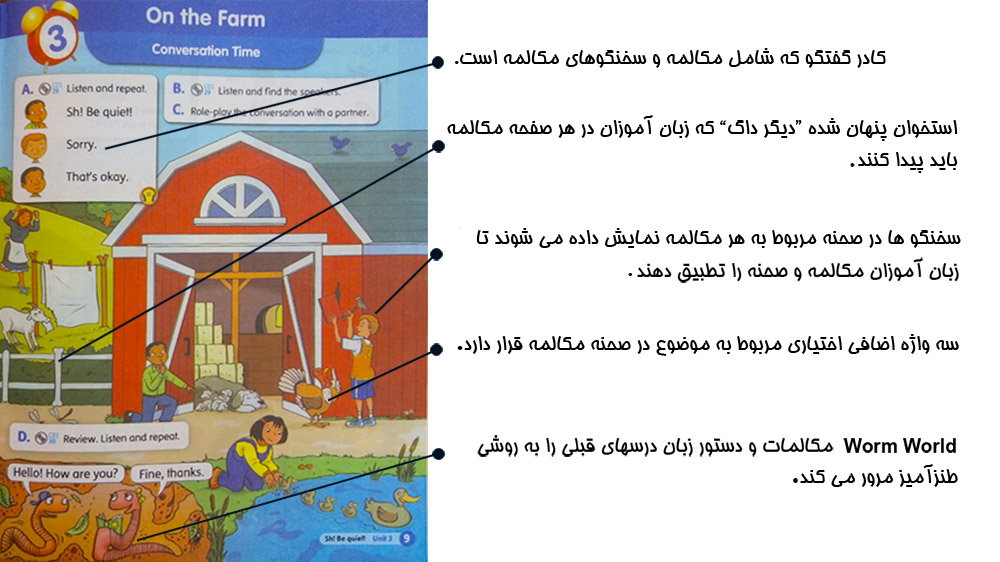
آمادهسازی و مرور
- بازی یا فعالیتی را انجام دهید تا آواهایی که زبان آموزان در جلسه قبل آموختهاند را مرور کنند. در هر برنامه درسی فعالیتی ارائه میشود. تمرین آوایی مربوط به کتاب کار را که دانش آموزان در کلاس بهعنوان تکلیف شب انجام دادهاند را بررسی کنید. پاسخها و دستورالعملهای دقیق در مورد چگونگی بررسی فعالیتها در انتهای کتاب معلم ارائه شده است.
ارائه بخش مکالمه
- مکالمه را به گونهای طراحی کنید که زبانآموزان بتوانند معنی را درک کنند. برای این کار، زبانآموزان (به همان تعدادی که در مکالمه حضور دارند) را به جلوی کلاس بیاورید و آنها را در مقابل هم قرار دهید. در پشت سر هر زبانآموز بایستید و خطهای مکالمهاش را مدل کنید. از حالات چهره و زبان بدن برای انتقال معنا استفاده کنید. به این ترتیب دانش آموزان میدانند که چه کسی کدام خط مکالمه را گفته است. هر طرح درس شامل نمونههایی از زبان طبیعی بدن و صورت برای هر خط از مکالمه است.
- معنی کلمات یا اصطلاحات جدید خاص را در مکالمه از طریق ترسیم، حرکات یا تصاویر آموزش دهید. اگر زبانآموزان معنی را درک کنند، زبان را بهتر حفظ میکنند. نمونههای مفصل در هر طرح درس ارائه شده است.
- مانند مرحله اول مکالمه را دوباره الگو برداری کنید تا زبانآموزان آن را دوباره بشنوند. آنها گوش میکنند و تکرار نمیکنند.
- کلاس را به تعداد سخنگوها در هر مکالمه گروهبندی کنید. هر خط از مکالمه را دوباره اجرا کنید. گروه A خط اول مکالمه را تکرار میکنند، گروه B خط دوم را و به همین ترتیب. سپس گروهها نقشها را تغییر میدهند و مکالمه را تکرار میکنند تا اینکه هر گروه هر نقش را تمرین کرده باشد.
- اکنون زبانآموزان آماده هستند تا مکالمه را به تنهایی و بدون هیچگونه الگویی انجام دهند. گروهها خطوط مناسب مکالمه را میگویند، سپس نقشها را تغییر میدهند و گفتگو را دوباره تکرار میکنند. این کار را ادامه دهید تا هر گروه نقش خود را اجرا کند.
اجرای داوطلبانه
واژگان دیگری را که میتوان در گفتگو جایگزین کرد، معرفی کنید و مکالمه را با این واژگان جدید تمرین کنید. بهعنوان مثال زبانآموزان کلمات Good afternoon و Good evening را با Good morning جایگزین میکنند.
درباره تصویر صحبت کنید
- زبانآموزان در این مرحله برای اولین بار کتاب خود را باز میکنند.
- در مورد آنچه در تصویر بزرگ اتفاق میافتد صحبت کنید تا بتوانید زبان را بازیابی کنید و صحنه را زنده کنید. مهم نیست که زبانآموزان معنی هر کلمه را درک کنند، زیرا این تمرین جهت قرار گرفتن در معرض زبان انگلیسی و بازیابی زبان قبلی در یک متن جدید است.
یک متن کوتاه خواندنی در هر برنامه درسی ارائه شده است. هنگام خواندن یک کلمه Bold شده در متن، به تصویرش در صحنه اشاره کنید. هنگام خواندن کلمه Italic در متن، پانتومیم آن را اجرا کنید. این کار معنی واژگان جدید را به زبانآموز منتقل میکند. شما میتوانید به جای کتاب از پوسترهای دیواری استفاده کنید و در مورد تصاویر صحبت کنید.
- به منظور استخراج زبان و جذب زبانآموزان درباره تصویرهای بزرگ سؤال کنید. زبانآموزان را تشویق کنید که با استفاده از واژگان، به عبارات یا جملات ساده پاسخ دهند. در صورت لزوم جواب را ارائه دهید. سؤالهای پیشنهادی در هر درس ارائه شده است.
Word Time و طرح درس آن
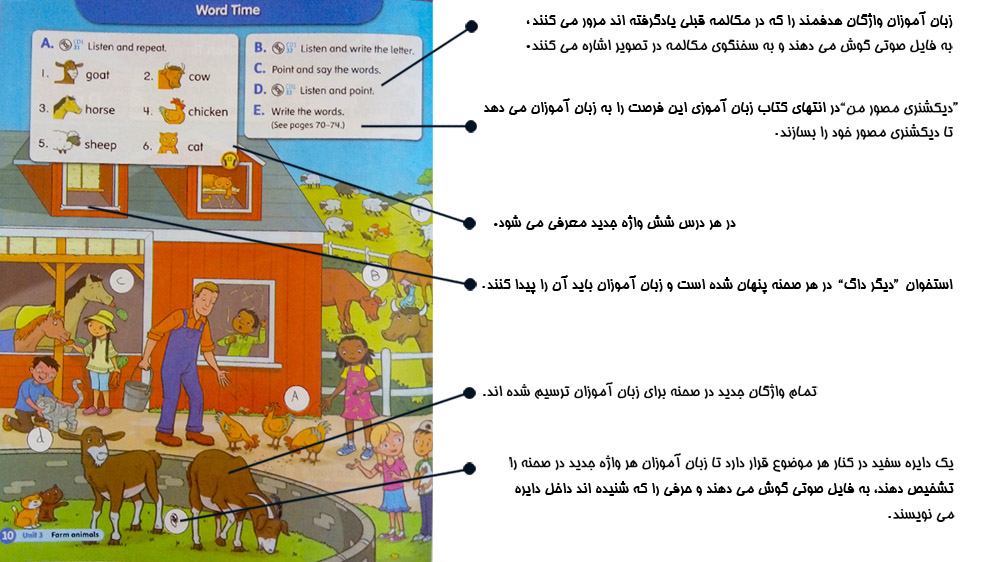
آمادهسازی و مرور
- یک بازی یا فعالیتی را انجام دهید که مکالمه آموخته شده درس قبلی را دوره کند. در هر طرح درس فعالیتی ارائه میشود.
- صفحه کار مربوط به مکالمه را که زبانآموزان در کلاس یا بهعنوان مشق شب انجام دادهاند را بررسی کنید. پاسخها و دستورالعملهای دقیق در مورد چگونگی بررسی فعالیتها در انتهای کتاب معلم ارائه شده است.
معرفی واژگان
- هر مورد واژگان را به گونهای معرفی کنید که زبانآموزان معنی هر کارت تصویری Word Time را بشنوند و درک کنند. زبانآموزان گوش میکنند. مکث کنید و نام کارت را دوباره بخوانید و زبانآموزان تکرار کنند. برای ایجاد چالش بیشتر، کارتها را بهصورت تصادفی انتخاب کنید و از زبانآموزان بخواهید که آنها را نام ببرند. روشهای جایگزین برای معرفی کلمات در صورت لزوم ارائه شده است.
درباره تصاویر صحبت کنید
- در این مرحله زبانآموزان برای اولین بار کتاب زبانآموزی خود را باز میکنند.
- بهعنوان مقدمه در مورد آنچه در تصویر بزرگ اتفاق میافتد صحبت کنید تا بتوانید زبان را بازیابی کنید و به تصویر جان ببخشید. مهم نیست که زبانآموزان معنی هر کلمه را درک کنند. این یک تمرین دریافتی بهتر با تمرکز به قرار گرفتن در معرض زبان انگلیسی و بازیابی زبان قبلی در یک متن جدید است.
در هر طرح درس یک متن کوتاه پیشنهادی گنجانده شده است. هنگام خواندن یک کلمه Bold در متن به تصویر آن در صفحه اشاره کنید. هنگام خواندن کلمه Italic در متن پانتومیم آن را اجرا کنید. این کار معنی واژگانی که زبانآموزان قبلاً نشنیدهاند را منتقل میکند.
- به منظور استخراج زبان و جذب زبانآموزان درباره تصاویر بزرگ سؤال کنید. زبانآموز را تشویق کنید که با استفاده از واژگان، به عبارات یا جملات ساده پاسخ دهند. در صورت لزوم جواب را ارائه دهید. سؤالهای پیشنهادی در هر درس ارائه شده است.
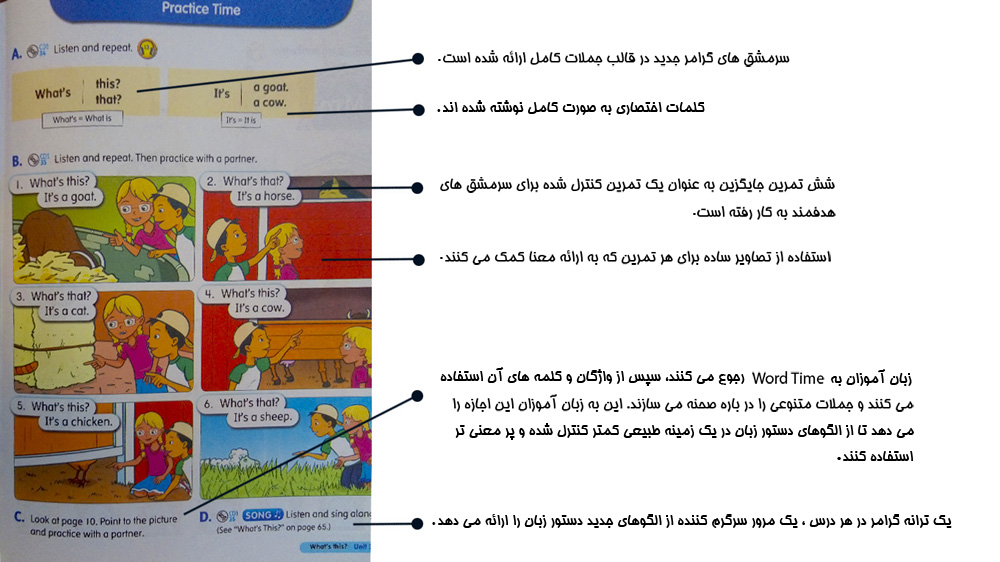
Practice Time و طرح درس آن
آمادهسازی و مرور
- بازی یا فعالیتی را انجام دهید تا آواهایی که زبان آموزان در جلسه قبل آموختهاند را مرور کنند. در هر برنامه درسی فعالیتی ارائه میشود. تمرین آوایی مربوط به کتاب کار را که دانش آموزان در کلاس بهعنوان تکلیف شب انجام دادهاند را بررسی کنید. پاسخها و دستور العملهای دقیق در مورد چگونگی بررسی فعالیتها در انتهای کتاب معلم ارائه شده است.
- صفحه کار مربوط به مکالمه را که زبانآموزان در کلاس بهعنوان مشق شب انجام دادهاند را بررسی کنید. پاسخها و دستورالعملهای دقیق در مورد چگونگی بررسی فعالیتها در انتهای کتاب معلم ارائه شده است.
- الگوهای قبلی که مربوط به الگوی هدف است را مرور کنید. بهعنوان مثال ابتدا "I like apples " را مرور کنید قبل از اینکه "?Do you like oranges" را معرفی کنید. فعالیتهای تفصیلی در صورت لزوم ارائه میشود.
معرفی الگوها انگلیش تایم
الگوهای هدف را گام به گام معرفی کنید. بهعنوان مثال:
(This is a (Tree: مجموعهای از کارتهای (Word time (Unit 2 را به هر زبان آموز اختصاص دهید و از او بخواهید که کارتها را در مقابل خود قرار دهد. مجموعهای از همین کارتهای تصویری را روی تخته قرار دهید. کارت درخت را لمس کنید و بگویید "This is a tree"، با تأکید روی کلمه This. زبانآموزان کارت درخت خود را لمس میکنند و تکرار میکنند. سپس روی تخته بنویسید"This is a tree". به هر واژه اشاره کرده و بخوانید. زبانآموزان تکرار کنند. همین کار را با گل، دریاچه، پرنده و پروانه انجام دهید.
(That's a (cloud: پنج قدم از تخته فاصله بگیرید به کارت ابر اشاره کنید و بگویید "That's a cloud". با تأکید روی کلمه That's. زبانآموزان به کارت روی تخته اشاره میکنند و تکرار میکنند. سپس روی تخته بنویسید "That's a cloud". به هر واژه اشاره کنید و بخوانید، زبانآموزان تکرار کنند. همین کار را با گل، درخت، دریاچه، پرنده و پروانه انجام دهید.
تمرین برای تسلط: هر کارت تصویر را لمس کرده یا به آن اشاره کنید و به روی کلمه This is تأکید کنید. زبانآموزان نیز یا کارتهای خود را لمس میکنند و یا به کارت روی تخته اشاره میکنند و میگویند (This is/That is) سپس یک داوطلب به جلوی کلاس میآید و نقش معلم را بازی میکند و با اشاره یا لمس کارت، جملات مورد نظر را بیان میکند.
هنگامی که دانش آموزان با الگوها آشنا شدند، فعالیتی را ارائه دهید که به دانش آموزان اجازه میدهد بلافاصله استفاده از الگوها را تمرین کنند. دستورالعمل صریح قوانین دستور زبان در سطوح پایین نه لازم است، نه توصیه میشود زیرا میتواند بیش از حد خسته کننده باشد.
Phonics Time و طرح درسی آن
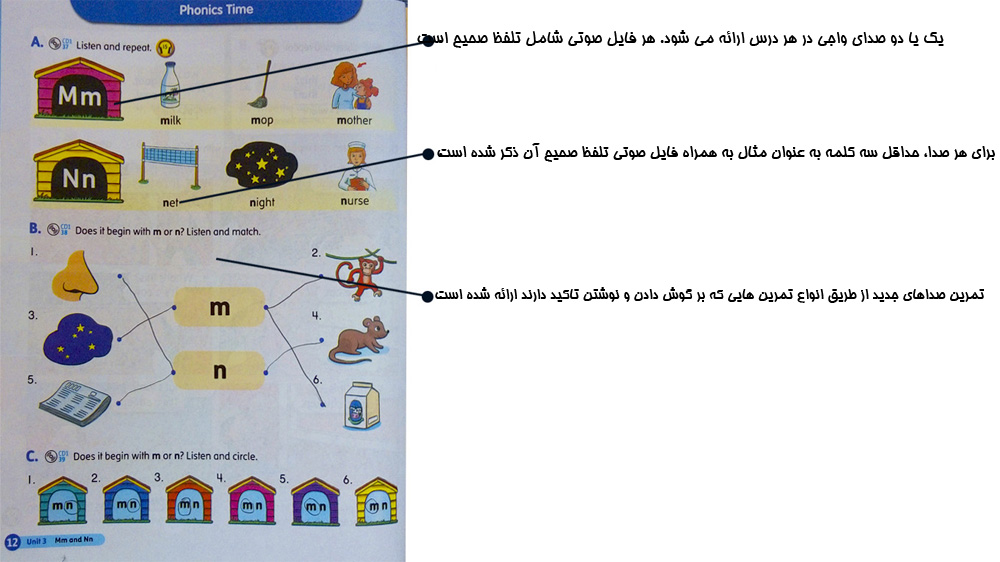
آمادهسازی و مرور
- بازی یا فعالیتی را انجام دهید تا آواهایی را که زبان آموزان در جلسه قبل آموختهاند را مرور کنند. در هر برنامه درسی فعالیتی ارائه میشود. تمرین آوایی مربوط به کتاب کار را که دانش آموزان در کلاس بهعنوان تکلیف شب انجام دادهاند را بررسی کنید. پاسخها و دستورالعملهای دقیق در مورد چگونگی بررسی فعالیتها در انتهای کتاب معلم ارائه شده است.
- صفحه کار مربوط به مکالمه را که زبانآموزان در کلاس بهعنوان مشق شب انجام دادهاند را بررسی کنید. پاسخها و دستورالعملهای دقیق در مورد چگونگی بررسی فعالیتها در انتهای کتاب معلم ارائه شده است.
- از آنجایی که آواها به تقویت مداوم نیاز دارند، یک بازی ترتیب دهید یا فعالیتی را انجام دهید که صداهایی که قبلاً آموختهاند را مرور کنند. فعالیتهای تفصیلی در هر برنامه درسی ارائه شده است.
معرفی صداها
- هر کلمه و آوای مورد نظر را با روشی گام به گام معرفی کنید تا با شنیدن هر آوا معنی هر کلمه را نیز درک کنند. برای انجام این کار، هر کارت تصویری Phonics Time را نگهدارید و هم صدای واژه و هم کل کلمه را ادا کنید. زبانآموزان تکرار میکنند. کارتها را روی تخته بچسبانید.
- کلمه مورد نظر را به روش زیر روی تخته بنویسید: حرف مورد نظر را بنویسید. صدای آن را هنگام اشاره به حرف ادا کنید و زبانآموزان تکرار کنند. بقیه کلمه را روی تخته بنویسید و صدای حرف مورد نظر را ادا کنید. سپس بقیه کلمه را بگویید. به هر دو بخش کلمه و سپس کل کلمه اشاره کنید و زبان آموزان تکرار کنند.
تمرین آوا
A) گوش کنید و تکرار کنید
توجه زبانآموزان را بر روی حروف، تصاویر و کلمات مورد نظر در بالای صفحه متمرکز کنید. فایل صوتی را پخش کنید. زبانآموزان گوش میدهند و تکرار میکنند. به تصاویر و کلمات موجود در کتابهای خود اشاره میکنند.
B/C/D) فعالیتهای اضافی
هر صفحه Phonics Time حداقل دو تمرین شنیداری اضافی برای تقویت مهارت شنیداری دارد. دستورالعملهای دقیق و در صورت لزوم، اسکریپتها و پاسخهای صوتی برای هر تمرین ارائه شده است.
آواهای آموختهشده در کتاب زبانآموز یک
جهت آشنایی با کلیه آواها در زبان انگلیسی به مقاله 44 آوای زبان انگلیسی مراجعه کنید.
Consonants
| Example word |
Sound |
Letter |
| ball |
/b/ |
b |
| desk |
/d/ |
d |
| feet |
/f/ |
f |
| garden |
/g/ |
g |
| hand |
/h/ |
h |
| kangaroo |
/k/ |
k |
| milk |
/m/ |
m |
| net |
/n/ |
n |
| pencil |
/p/ |
p |
| sea |
/s/ |
s |
| table |
/t/ |
t |
| van |
/v/ |
v |
| water |
/w/ |
w |
| zebra |
/z/ |
z |
Vowels
| Example word |
Sound |
Letter |
| ant |
/æ/ |
a |
| bed |
/ε/ |
e |
| dig |
/I/ |
i |
| hot |
/ä/ |
o |
| bus |
/Λ/ |
u |
English Time
Course Description
English Time is a six-level communicative course intended for elementary school students studying English for the first time. It is designed specifically for children studying in an English as a Foreign Language (EFL) context who do not generally hear English spoken outside the classroom. The syllabus progresses at a natural and steady pace, offering students many opportunities to practice each new language item.
The aim of the series is to develop students' speaking, listening, reading, and writing skills through activities that reward their curiosity and appeal to their sense of fun. Three recurring characters – Ted, Annie, and Digger the Dog – help focus student interest and involvement throughout the course.
The English Time series is designed to be preceded by the two-level introductory series Magic Time. These two series can be used separately or as one complete eight-level course. The Magic Time syllabus provides a solid foundation of vocabulary and communicative language on which the syllabus of English Time is built.
Each level of English Time includes the following component:
Student Book with Student Audio CD, Workbook, Workbook with Online Practice, Class Audio CD, Teacher's Book with a test Center CD-ROM and Online Practice, Picture Cards, Wall Charts, iTools.
Components
The Student Book
The Student Books feature beautiful, full-color illustration, and a clear, simple design. The illustrations draw students into the pages to explore and experience the language, enhancing student interest and motivation. English Time Levels 1-4 feature twelve 4-page units and four 2-page reviews. Each unit features a theme, such as At Home or At School, to provide a context to the language. Each page of a unit features a single language function so that the focus of the page is clear. The short units allow students to feel they are progressing rapidly, thus building their confidence and motivation. After every three units, the 2-page reviews recycle previously-learned language in new and meaningful contexts. After every review, the cross curricular sections provide students with additional information and vocabulary sets linked to subjects such as: math, nature, geography. Students reinforce their knowledge on different subjects and practice new vocabulary through the Project activities pages that follow the cross-curricular sections.
At the back of each Student Book is My Picture Dictionary, in which student write the vocabulary words as they learn them. Also at the back of the Student Books four Checklists (one for every three units). These give students an opportunity to check what they know, thus building their confidence and allowing parents to follow their children's progress in English.
The Workbooks
There are two versions of the Workbooks: a stand-alone version and a version with access to Online Practice. The workbooks are a natural extension of the Student Books, providing additional reading and writing reinforcement for each lesson. They offer an excellent opportunity for teachers to assess student comprehension and language retention. A unique feature of the Levels 1-2 Workbooks is the support box at the top of each page which provides the target language for students to use as a reference as they complete the exercises. Therefore, students do not have to spend time searching for the target language items in their Student Books.
Achievement Test
A unit test after each unit, a midterm test, and a final test help you assess your students, mastery of the vocabulary, grammar, and conversational language of the syllabus. All the material for the Achievement Tests is also printed in the Teacher's Book (pages 143-164).
Cambridge Young Learners' practice tests
These tests provide specific practice in the style of the Cambridge Young Learners examinations, enabling you to choose task types and create practice materials for these tests. Even if you are not preparing your students for these examinations, you can still use the tasks to create extra practice, review tests, or worksheets.
Course Philosophy
English Time is based on the premise that children learn best when their natural curiosity and sense of fun are engaged, and when new language is introduced in small, manageable amounts. English Time introduces language in a spiraling syllabus that gradually builds on and reinforces previously learned language. Thus at each new level students are able to maintain and build on the language they know.
The unit topics and situations are both familiar and of universal appeal to children. Students immediately relate to these situations, resulting in greater language production and retention. English Time emphasize student-centered learning, as it creates opportunities for students to produce language in a manner that most closely resembles "real life" communication. For this reason, practice and review activities in English Time involve both pair work and group work.
The theory of multiple intelligences suggests that in any language class there are students with different learning styles (see Multiple Intelligences, Teacher Resource Guide, page 21).
Therefore English Time activities are designed to take a wide range of learning styles into account in order to engage as many students as possible during each lesson.
The English Time lesson plans do not follow one particular teaching methodology. Instead, a variety of different, successful methodologies are employed to provide exciting, varied lessons that stimulate and appeal to as many students as possible.
Students hear the target language before they produce it (receptive exposure before production). Listening is emphasized so that students are exposed to correct pronunciation and intonation.
Lesson Planning
Thorough planning and preparation are crucial to the success of any lesson. A Well-prepared lesson includes more activities than many seem necessary. Preparation of multiple activities allows teachers to maintain the pace of the lesson, abandon activities that are not working, and keep the focus on students and their learning.
A sound lesson plan includes activities to review previously learned language, introduce new language, and practice all language in an organized, educationally sound, and enjoyable manner. English Time Teacher's Books provide a detailed, step-by-step lesson plan for each Student Book page. Teachers are encouraged to modify these lesson plans to meet their individual needs.
English Time Lesson Plans
-
Warm-Up and Review
Each lesson plan begins with a quick, fun activity that reviews the language introduced in the previous lesson and other related language. This activity helps students to both recall the language and "switch" to English-speaking mode.
-
Introduce the Target Language
New language is introduced before students open their Student Book so that they focus on the meaningful demonstration of the language. Step-by-step suggestions show how to introduce the target language using Picture Cards, realia, drawings, and/or gestures.
-
Practice the Target Language
Students open their Student Book at this stage. Each Student Book page provides exercises to practice the language. The Teacher's Book provides detailed instructions on how to fully exploit each Student Book page. The audio script, answer, and ideas on how to check exercises are provided where appropriate.
-
Games and Activities
All lessons include games and activities that offer students further practice with the target language. Activities frequently combine previously learned language with the target language, so that students are continually building on what they have learned. Teachers can choose games and activities that are appropriate to their needs. Optional photocopiable Worksheets at the back of the Teacher's Book provide extra grammar and phonics practice.
Each lesson plan concludes with a quick, fun activity which reviews the new language, gives the lesson a feeling of closure, and ends the class on a positive note.
Conversation Time Sample Page and Lesson Plan
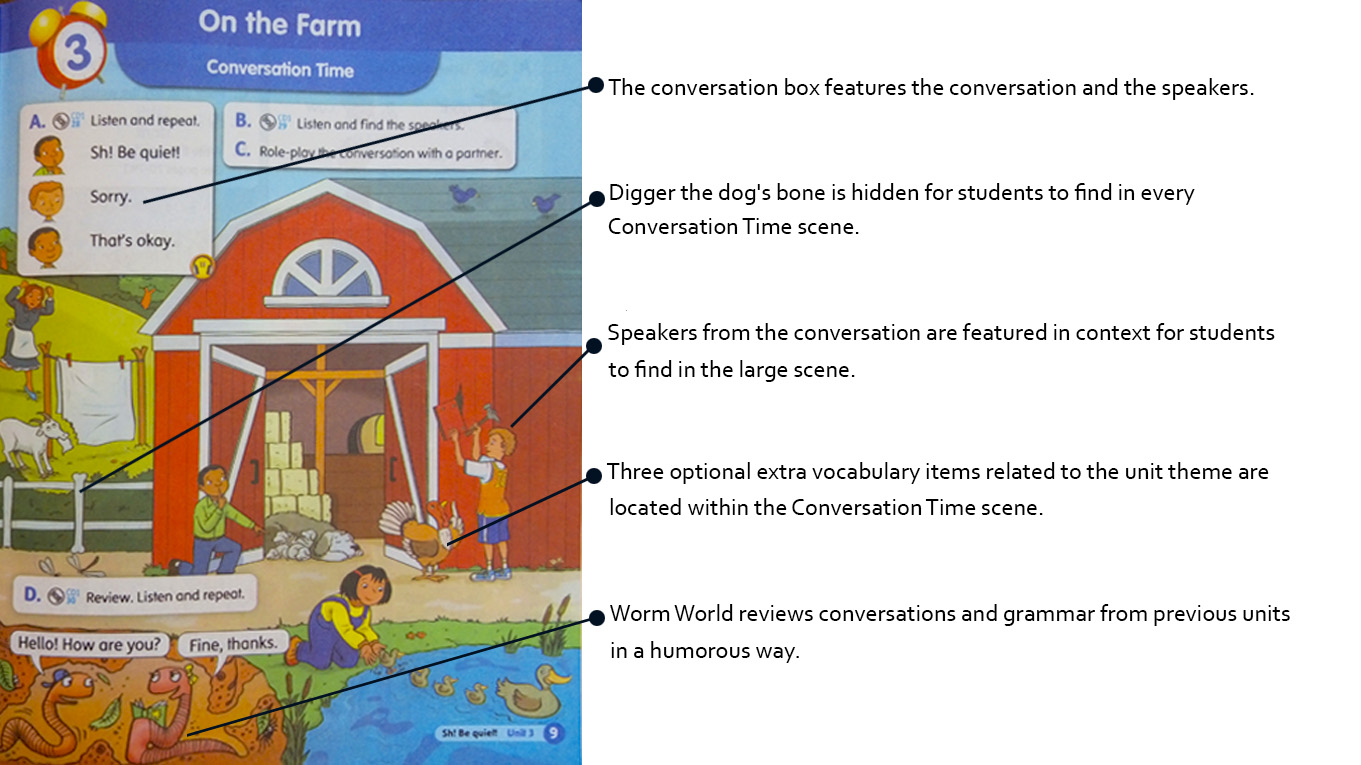
Warm-Up and Review
- Play a game or do an activity which reviews the phonics sounds learned in the previous lesson. An activity is provided in each lesson plan.
- Check the phonics Time Workbook page that students did in class or for homework. Answers and detailed instructions on how to check the activities are provided at the back of the Teacher's Book.
Introduce the Conversation
- Model the conversation in such a way that students can understand the meaning. To do this, bring students (the same number of students as there are speakers in the conversation) to the front of the classroom and have them face each other. Stand behind each student and model his/her line(s) of the conversation, using appropriate facial expressions and body language to convey meaning. This way students know who says which line of the conversation. Each Lesson Plan contains examples of natural body language and facial expressions for each line f the conversation.
- Teach the meaning of specific new words or phrases in the conversation through drawings, actions or pictures. Students retain language better if they understand the meaning. Detailed examples are provided in each lesson plan.
- Model the conversation again, as in Step 1, so that students hear it again. Students listen and do not repeat.
- Divide the class into groups (the same number of groups as there are speakers in the conversation). Model each line of the conversation again. Group A repeats the first line of the conversation, Group B repeats line two, and so on. Groups then change roles and repeat the conversation until each group has practiced each role.
- Students are now ready to say the conversation on their own, without any modeling. Groups say the appropriate lines of the conversation. They then change roles and say the conversation again. Continue until each group has taken on each role. Prompt when necessary.
OPTIONAL SUBSTITUTION
Introduce other vocabulary that can be substituted into the conversation, and practice the conversation with this new vocabulary. For example: Students substitute Good afternoon and Good evening for Good morning.
Talk About the Picture
- Students open their Student Book for the first time at this point.
- Talk about what is happening in the large scene in order to recycle language and bring the picture to life. It is not important that students understand each word as this is a receptive exercise focusing on exposure to English and recycling previous language in a new context. A suggested short reading is provided in each lesson plan. When reading a word in bold type, point to this picture in the scene. When reading an italicized word, pantomime it. The meaning of words student have not heard before. Alternatively, use the Wall Charts instead of a Student Book to talk about the picture.
- Ask questions about the large scene in order to elicit language and draw students further into the picture. Encourage students to answer using words, phrases, or simple sentences. Provide the answer if necessary. Suggested questions are provided in each lesson plan.
Word Time Sample Page and Lessen Plan
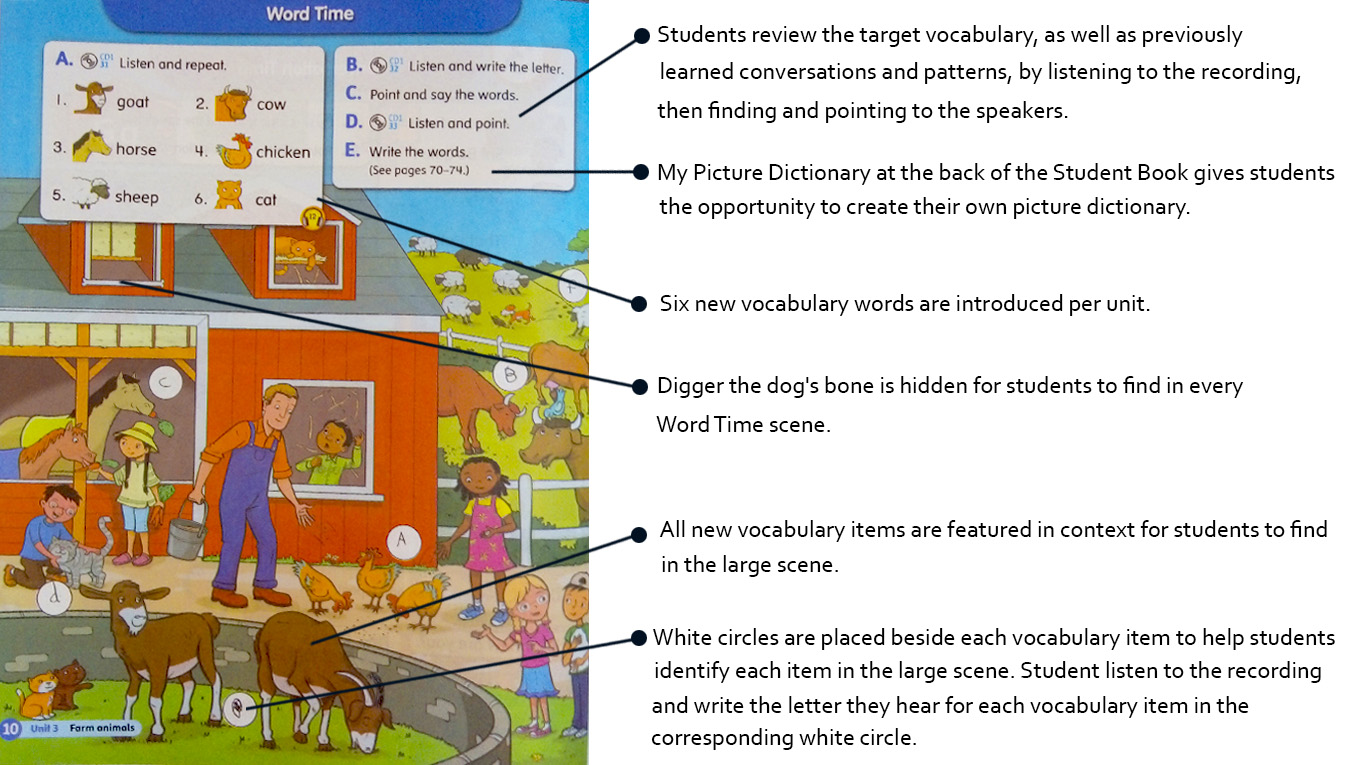
Warm-Up and review
- Play a game or do an activity which reviews the conversation learned in the previous lessen. An activity is provided in each lesson plan.
- Check the Conversation Time Workbook page that students did in class or for homework. Answers and detailed instructions on how to check the activities are provided at the back of the Teacher's Book.
Introduce the words
Introduce each vocabulary item in such a way that students both hear and understand the meaning of each Word Time Picture Card one by one. Students listen. Hold up and name the cards again, and have students repeat. For added challenge, hold up the cards in random order and have students name them. Alternate methods for introducing the words are provided where appropriate.
Talk About the Picture
- Students open their Student Books for the first time at this point. They look at the large scene and name anything they can.
- As in conversation Time, talk about what is happening in the large scene in order to recycle language and bring the picture to life. It is not important that students understand each word. This is a receptive exercise focusing on exposure to English and recycling previous in a new context. A suggested short reading is provided in each lesson plan. When reading a word in bold type, point to its picture in the scene. When reading an italicized word, pantomime it. This conveys the meaning of words students have not heard before.
- Ask question about the large scene in order to elicit language and draw students further into the picture. Encourage students to answer using words, phrases, or simple sentences. Provide the answers if necessary. Suggested questions are provided in each lesson plan.
Practice Time Sample Page and Lesson Plan
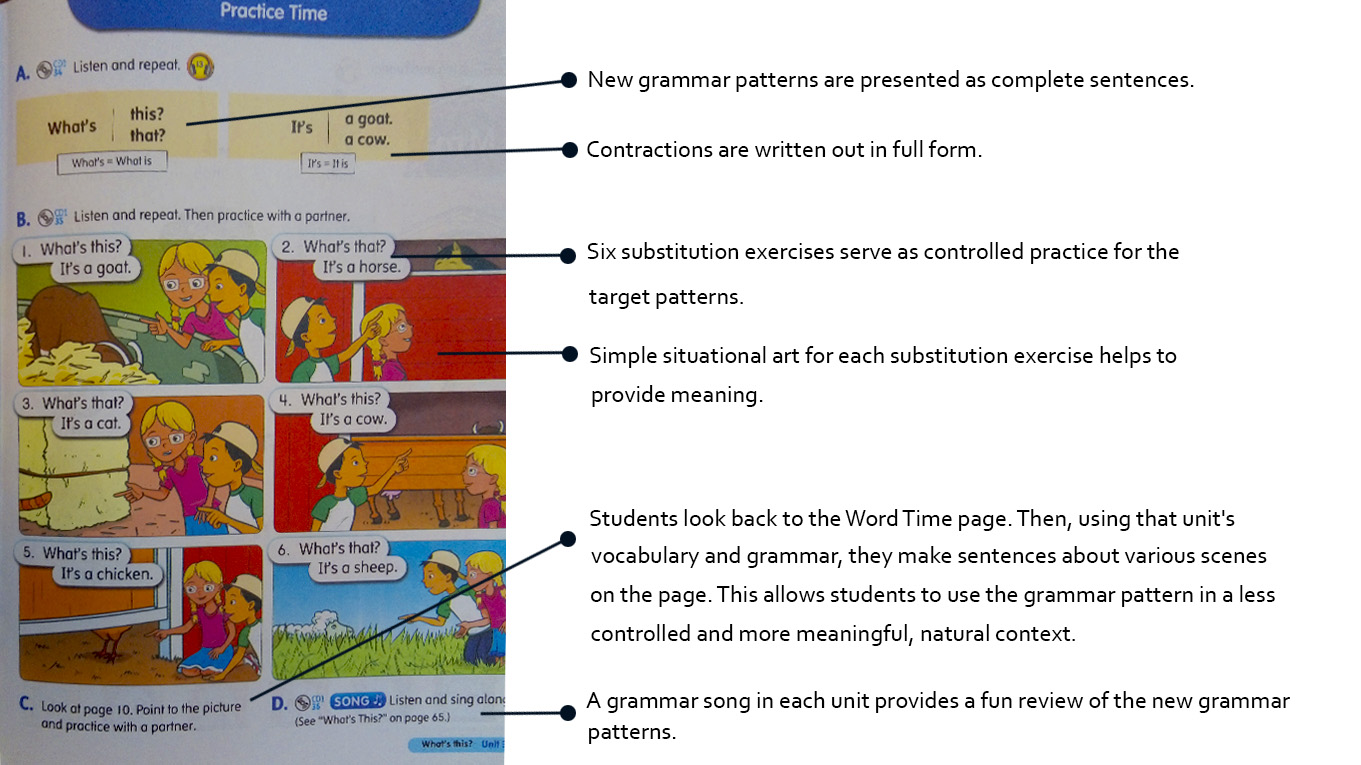
Warm-Up and review
- Play a game or do an activity which review the vocabulary learned in the previous lesson. An activity is provided in each lessen plan.
- Check the Word Time Workbook page that students did in class or for homework. Answers and detailed instructions on how to check the activities are provided at the back of the Teacher's Book.
- Review any previous patterns that pertain to the target pattern. For example: Review I like apples before introducing Do you like Oranges? Detailed activities are provided where appropriate.
Introduce the Patterns
Introduce the target patterns in a methodical, step-by-step way. For example:
- This is a (tree). Give each student a set of (Unit 2) Word Time Picture Cards, and have them place the cards face up in front of them. Stand a set of these same picture cards on the board tray. Touch the tree card and say This is a tree, stressing This. Students touch their tree card and repeat. Then write This is a tree. On the board. Point to and read each word. Students repeat. Do the same with flower, tree, lake, bird, and butterfly.
- That's a (cloud). Take five steps away from the board tray. Point to the cloud card and say That's a cloud. Stressing That's. Students point to the cloud card on the board tray and repeat. Then write That's a cloud. On the board. Point to and read each word. Students repeat. Do the same with flower, tree, lake, bird, and butterfly.
- Practice for Fluency. Touch or point to each picture card and elicit (This is) a butterfly. Students touch their cards or point to the cards on the board tray while saying This is/That's. A volunteer then comes to the front of the classroom and takes on the teacher's role, touching or pointing to each card, and eliciting the target sentences. Once students are familiar with the patterns, provide an activity which allows students to practice using the patterns immediately. Explicit instruction of grammar rules is neither necessary nor recommended in the lower levels, as it could prove too overwhelming.
Phonics Time Sample Page and Lesson Plan
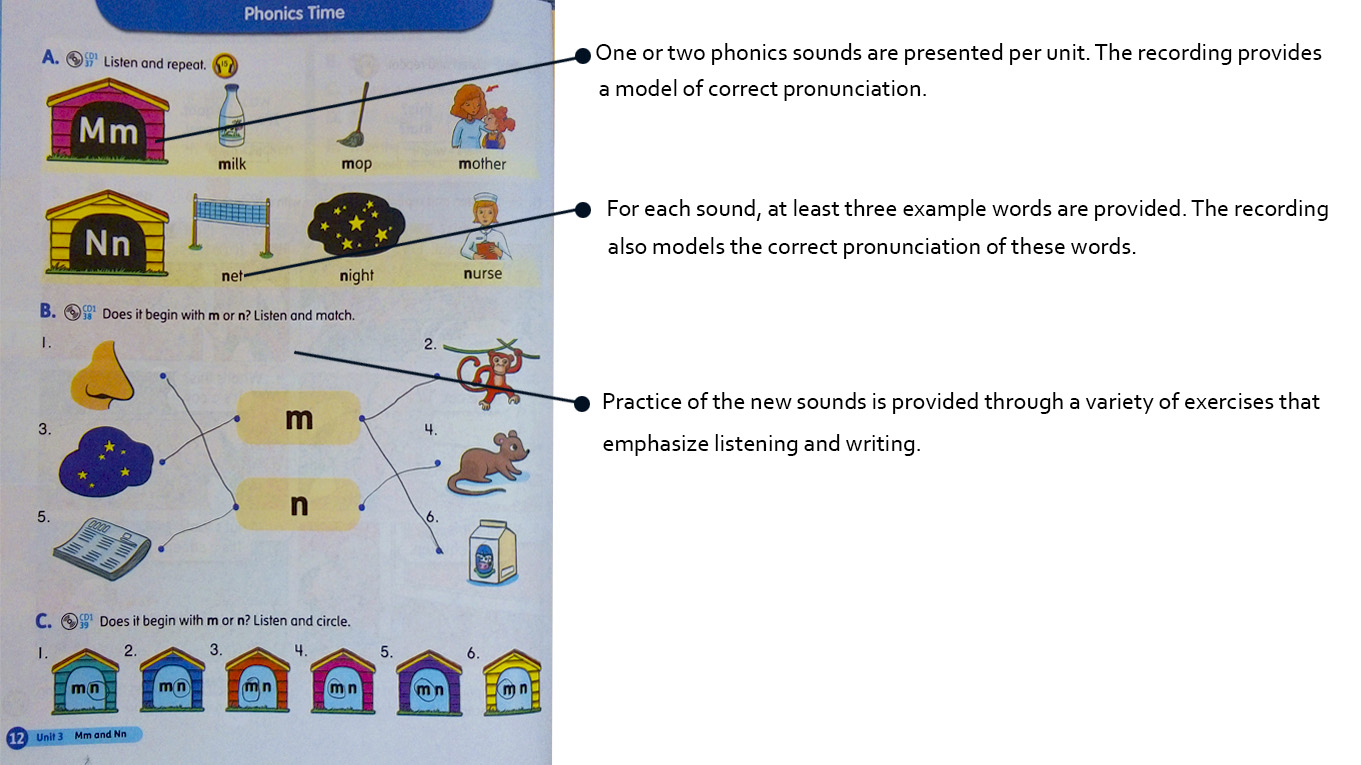
Warm-Up and Review
- Play a game or do an activity which reviews the grammar patterns learned in the previous lesson. An activity is provided in each lesson plan.
- Check the Practice Time Workbook page that students did in class or for homework. Answer and detailed instructions on how to check the activities are provided at the back of the Teacher's Book.
- As phonics needs constant reinforcement, play a game or do an activity which reviews previously learned sounds. Detailed activities are provided in each lesson plan.
Introduce the Sounds
- Introduce each target phonics sound and word in a methodical, step-by-step way so that students both hear the target sounds and understand the meaning of each target word. To do this, hold up each Phonics Time Picture Card and say both the target sound and the whole word. Students repeat. Attach the cards to the board.
- Write each target word on the board in the following way: Write the target letter. Say its sound while pointing to the letter. Students repeat. Write the rest of the word on the board and say the target sound and then the rest of the word, pointing to the two parts of the word and then the whole word. Students repeat.
Practice the Sounds
-
Listen and repeat.
Focus student's attention on the target letters, pictures, and words at the top of the page. Play the recording. Students listen and repeat, pointing to the pictures and words in their books.
B/C/D (Additional activities).
Each Phonics Time page has at least two additional listening exercises to reinforce the sounds. Detailed instructions and where appropriate, audio scripts and answers, are provide for each exercise.
Sounds Taught in Student Book 1
|
Consonants
|
|
Letter
|
Sound
|
Example word
|
|
b
|
/b/
|
ball
|
|
d
|
/d/
|
desk
|
|
f
|
/f/
|
feet
|
|
g
|
/g/
|
garden
|
|
h
|
/h/
|
hand
|
|
k
|
/k/
|
kangaroo
|
|
m
|
/m/
|
milk
|
|
n
|
/n/
|
net
|
|
p
|
/p/
|
pencil
|
|
s
|
/s/
|
sea
|
|
t
|
/t/
|
table
|
|
v
|
/v/
|
van
|
|
w
|
/w/
|
water
|
|
z
|
/z/
|
zebra
|
|
|
|
Vowels
|
|
Letter
|
Sound
|
Example word
|
|
a
|
/ æ /
|
ant
|
|
e
|
/ε/
|
bed
|
|
i
|
/I/
|
dig
|
|
o
|
/ä/
|
hot
|
|
u
|
/Λ/
|
bus
|